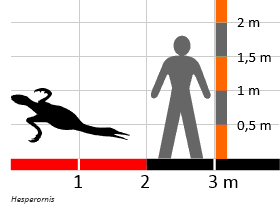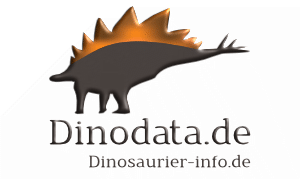Hesperornis regalis

Marsh, 1872
Klassifizierung: Hesperornithidae
Ernährung: piscivor
Bedeutung des Namen: westlicher Vogel
Hesperornis gehörte zu den Hesperornithiformes, einer Gruppe von bezahnten, flugunfähigen Tauchvögeln und ernährte sich wahrscheinlich überwiegend von Fischen und Tintenfischen. Hesperornis war ein großer Vogel und erreichte bis zu 1,5 m Länge. Er besaß praktisch keine Flügel und schwamm mit seinen kräftigen Hinterbeinen. Dank seiner großen Füße, die wie bei einem Pinguin mit Schwimmhäuten ausgestattet waren, konnte er vermutlich sehr schnell durch das Wasser gleiten. Hesperornis war nicht in der Lage, an Land nicht laufen oder aufrecht stehen wie die heutigen Pinguine, da sich seine Beine hinten am Körper befanden, er rutschte an Land daher vermutlich auf dem Bauch.
Länge: 1,8 m
Gewicht: 15 kg
Holotyp: Y.P.M. 1206
Fundort: Niobrara Chalk Formation, Smoky Hill, Logan County, Kansas (USA)

© Dinodata.de

© M. Shiraishi
Weitere Informationen
A Middle Campanian, Nonmarine Occurrence of the Cretaceous Toothed Bird Hesperornis Marsh / Richard C. Fox , 1974 / Canadian Journal of Earth Sciences, 1974, 11(9): 1335-1338, https://doi.org/10.1139/e74-127
/ Richard C. Fox , 1974 / Canadian Journal of Earth Sciences, 1974, 11(9): 1335-1338, https://doi.org/10.1139/e74-127
Comparative osteohistology of Hesperornis with reference to pygoscelid penguins: the effects of climate and behaviour on avian bone microstructure / Laura E. Wilson, Karen Chin, 2014 / R. Soc.opensci.1: 140245. dx.doi.org/10.1098/rsos.140245 /
/ Laura E. Wilson, Karen Chin, 2014 / R. Soc.opensci.1: 140245. dx.doi.org/10.1098/rsos.140245 / PDF
PDF
Cranial Kinesis in the Late Cretaceous Birds Hesperornis and Parahesperornis / Paul Bühler, Larry D. Martin, Lawrence M. Wittmer, 1988 / The Auk 105: 111-122
/ Paul Bühler, Larry D. Martin, Lawrence M. Wittmer, 1988 / The Auk 105: 111-122
Histological Evidence for the Systematic Position of Hesperornis (Odontornithes: Hesperornithiformes) / Peter Houde, 1987 / The Auk - Short Communications, Vol.104
/ Peter Houde, 1987 / The Auk - Short Communications, Vol.104
Mandibular kinesis in Hesperornis / Larry D. Martin, Virginia L. Naples, 2008 / ORYCTOS vol. 7, 2008
/ Larry D. Martin, Virginia L. Naples, 2008 / ORYCTOS vol. 7, 2008
New observations on the skull of Hesperornis with reconstructions of the bony palate and otic region / Andrzej Elzanowski, 1991 / Postilla 207: 1-20
/ Andrzej Elzanowski, 1991 / Postilla 207: 1-20
New record of Hesperornis rossicus (Aves, Hesperornithiformes) in the Campanian
of Saratov Province, Russia / Andrei V. Panteleyev, Evgenii V. Popov, Alexander O. Averianov, 2004 / Paleontological Research, vol. 8, no. 2, pp. 115–122
/ Andrei V. Panteleyev, Evgenii V. Popov, Alexander O. Averianov, 2004 / Paleontological Research, vol. 8, no. 2, pp. 115–122
On the Dermal Covering of Hesperornis / S. W. Williston, 1896 / Kansas University Quarterly 5(1):53-54, pl. II.
/ S. W. Williston, 1896 / Kansas University Quarterly 5(1):53-54, pl. II.
Synchrotron imaging of dentition provides insights into the biology of Hesperornis and Ichthyornis, the "last" toothed birds / Maitena Dumont, Paul Tafforeau, Thomas Bertin, Bhart-Anjan Bhullar, Daniel Field, Anne Schulp, Brandon Strilisky, Béatrice Thivichon-Prince, Laurent Viriot, Antoine Louchart, 2016 / BMC Evolutionary Biology volume 16, Article number: 178 (2016)
/ Maitena Dumont, Paul Tafforeau, Thomas Bertin, Bhart-Anjan Bhullar, Daniel Field, Anne Schulp, Brandon Strilisky, Béatrice Thivichon-Prince, Laurent Viriot, Antoine Louchart, 2016 / BMC Evolutionary Biology volume 16, Article number: 178 (2016) PDF
PDF
The Fossil Remains of a Species of Hesperornis Found in Montana / R. W. Shufeldt, 1915 / The Auk Vol. XXXII, 1915
/ R. W. Shufeldt, 1915 / The Auk Vol. XXXII, 1915
The Jaws of the Cretaceous Toothed Birds, Ichthyornis and Hesperornis / Joseph T. Gregory, 1952 / Condor 54 (2): 73–88
/ Joseph T. Gregory, 1952 / Condor 54 (2): 73–88
The Occurrence of Hesperornis in the Late Cretaceous Niobrara Formation of South Dakota / James E. Martin, Daniel W. Varner, 1992 / Proc. S. D. Acad. Sci., Vol.71.
/ James E. Martin, Daniel W. Varner, 1992 / Proc. S. D. Acad. Sci., Vol.71.
- - - - -
Bildlizenz
Größenvergleich © Dinodata.de:
 Creative Commons 4.0 International (CC BY 4.0)
Creative Commons 4.0 International (CC BY 4.0)
- - - - -
Grafiken und Illustrationen von M. Shiraishi



